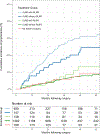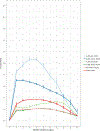Timing of Lymphedema After Treatment for Breast Cancer: When Are Patients Most At Risk?
- PMID: 30165125
- PMCID: PMC6524147
- DOI: 10.1016/j.ijrobp.2018.08.036
Timing of Lymphedema After Treatment for Breast Cancer: When Are Patients Most At Risk?
Abstract
Purpose: The purpose of the study was to determine when the risk of lymphedema is highest after treatment of breast cancer and which factors influence the time course of lymphedema development.
Methods and materials: Between 2005 and 2017, 2171 women (with 2266 at-risk arms) who received surgery for unilateral or bilateral breast cancer at our institution were enrolled. Perometry was used to objectively assess limb volume preoperatively, and lymphedema was defined as a ≥10% relative arm-volume increase arising >3 months postoperatively. Multivariable regression was used to uncover risk factors associated with lymphedema, the Cox proportional hazards model was used to calculate lymphedema incidence, and the semiannual hazard rate of lymphedema was calculated.
Results: With a median follow-up of 4 years, the overall estimated 5-year cumulative incidence of lymphedema was 13.7%. Significant factors associated with lymphedema on multivariable analysis were high preoperative body mass index, axillary lymph node dissection (ALND), and regional lymph node radiation (RLNR). Patients receiving ALND with RLNR experienced the highest 5-year rate of lymphedema (31.2%), followed by those receiving ALND without RLNR (24.6%) and sentinel lymph node biopsy with RLNR (12.2%). Overall, the risk of lymphedema peaked between 12 and 30 months postoperatively; however, the time course varied as a function of therapy received. Early-onset lymphedema (<12 months postoperatively) was associated with ALND (HR [hazard ratio], 4.75; P < .0001) but not with RLNR (HR, 1.21; P = .55). In contrast, late-onset lymphedema (>12 months postoperatively) was associated with RLNR (HR, 3.86; P = .0001) and, to a lesser extent, ALND (HR, 1.86; P = .029). The lymphedema risk peaked between 6 and 12 months in the ALND-without-RLNR group, between 18 and 24 months in the ALND-with-RLNR group, and between 36 and 48 months in the group receiving sentinel lymph node biopsy with RLNR.
Conclusions: The time course for lymphedema development depends on the breast cancer treatment received. ALND is associated with early-onset lymphedema, and RLNR is associated with late-onset lymphedema. These results can influence clinical practice to guide lymphedema surveillance strategies and patient education.
Copyright © 2018 Elsevier Inc. All rights reserved.
Conflict of interest statement
Figures


References
Publication types
MeSH terms
Grants and funding
LinkOut - more resources
Full Text Sources
Other Literature Sources
Medical

